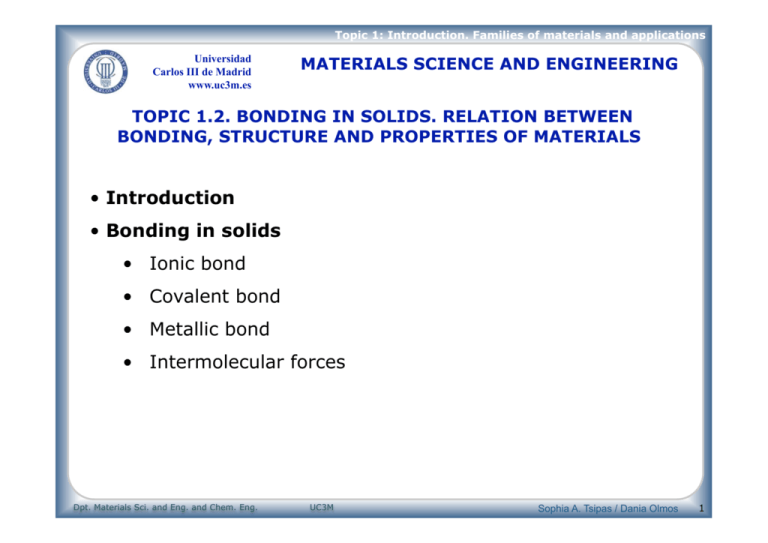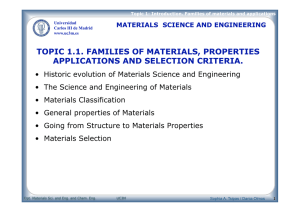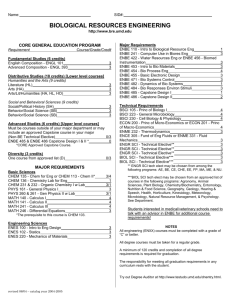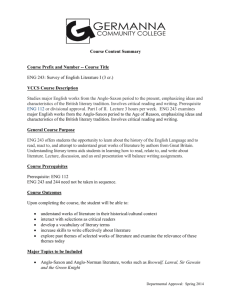topic 1.2. bonding in solids. relation between
advertisement

Topic 1: Introduction. Families of materials and applications Universidad Carlos III de Madrid www.uc3m.es MATERIALS SCIENCE AND CIENCIA E INGENIERÍA DEENGINEERING MATERIALES TOPIC 1.2. BONDING IN SOLIDS. RELATION BETWEEN BONDING, STRUCTURE AND PROPERTIES OF MATERIALS • Introduction • Bonding in solids • Ionic bond • Covalent bond • Metallic bond • Intermolecular forces Dpt. Materials Sci. and Eng. and Chem. Eng. UC3M Sophia A. Tsipas / Dania Olmos 1 Topic 1: Introduction. Families of materials and applications INTRODUCTION Nature of bonding <> properties <> type of materials <> Processing and applications Applications Processing Structure Properties Dpt. Materials Sci. and Eng. and Chem. Eng. UC3M Sophia A. Tsipas / Dania Olmos 2 Topic 1: Introduction. Families of materials and applications IONIC BOND It forms between a metal and a non metal. There is electron transfer from the less electronegative atom to the more electronegative . Bonding forces ⇒ F electrostatic attraction between opposite charged ions. • Pure ionic bond: ideal. • ⇒ Always exists covalent participation Dpt. Materials Sci. and Eng. and Chem. Eng. UC3M Sophia A. Tsipas / Dania Olmos 3 Topic 1: Introduction. Families of materials and applications IONIC BOND Ionic compounds are crystalline solids It is a non directional bond formed by strong electrostatic interactions LATTICE ENERGY: Energy released when a mole of ionic solid is formed from its ions in the gas state. Na+ Cl- Dpt. Materials Sci. and Eng. and Chem. Eng. Born-Haber cycle for LiF. Step ΔH(kJ/mol) Sublimation of Li 155.2 Dissociation of F2 (g) 150.6 Ionization of Li(g) 520 Gain of e- of F(g) -328 Formation of LiF from Li(s) and ½F2(g) -594.1 UC3M Sophia A. Tsipas / Dania Olmos 4 Topic 1: Introduction. Families of materials and applications IONIC BOND LATTICE ENERGY: Many properties are dependant on the lattice energy (melting point, hardness, thermal expansion coefficient) Ionic Solids Lattice Energies (kJ/mol) Melting point (oC) LiCl -829 613 NaCl -766 801 KCl -686 776 RbCl -670 715 CsCl -649 646 MgO -3932 2800 CaO -3583 2580 SrO -3311 2430 BaO -3127 1923 Dpt. Materials Sci. and Eng. and Chem. Eng. UC3M When the ion size ↑ ⇒ lattice energy ↓ and Tf ↓ Valence +1 Valence +2 Valance number ↑ ⇒ lattice energy ↑ ⇒ Tf ↑ Sophia A. Tsipas / Dania Olmos 5 Topic 1: Introduction. Families of materials and applications IONIC BOND • General properties of ionic compounds Strong electrostatic attraction High melting and evaporation points Hard and brittle solids at room temperature Deformation External force Repulsive forces -> Fracture They do not conduct electricity (except in molten state or when dissolved in water) Water soluble. Dpt. Materials Sci. and Eng. and Chem. Eng. UC3M Sophia A. Tsipas / Dania Olmos 6 Topic 1: Introduction. Families of materials and applications COVALENT BOND Generally it forms between the non metallic elements of the periodic table It forms by electron sharing Examples:︰ H・+・H → H∶H or H━H Bond pair Lone pairs Dpt. Materials Sci. and Eng. and Chem. Eng. UC3M Sophia A. Tsipas / Dania Olmos 7 Topic 1: Introduction. Families of materials and applications POLAR COVALENT BOND H + H + Cl Cl Non-polar covalent bond + H Cl Polar covalent bond ・= Atomic nucleus center of + ve charge + == center of -ve charge Dipole moment General Chemistry Principles and modern applications, 8th ed., RF Petrucci, WS Harwood, G Herring µ=Qxr r = Distance between atoms; Q =charge Units: Debye, D; 1 D = 3.33 10-30 C·m Dpt. Materials Sci. and Eng. and Chem. Eng. UC3M Xi : electronegativity of element i Sophia A. Tsipas / Dania Olmos 8 Topic 1: Introduction. Families of materials and applications COVALENT BOND • Properties of the compounds with covalent bonds Covalent Solids Formed by a system of continuous covalent bonds Non conductive LATTICES both in the solid and in the molten state Diamond, boron nitride, quartz (SiO2), silicon carbide (SiC) Hard and incompressible Tf high, non volatile insoluble graphite Diamond http://commons.wikimedia.org/wiki/File:Graphit_gitter.png Substances with covalent bonds Dpt. Materials Sci. and Eng. and Chem. Eng. UC3M Sophia A. Tsipas / Dania Olmos 9 Topic 1: Introduction. Families of materials and applications METALLIC BONDS • Model of a sea of electrons – Atomic nucleus surrounded from a sea of e-. – Metallic shine . – Workability. Applied force Applied force + + + + + + + + + + + + Dpt. Materials Sci. and Eng. and Chem. Eng. Deformation + + + + + + + + + + + + UC3M Sophia A. Tsipas / Dania Olmos 10 Topic 1: Introduction. Families of materials and applications METALLIC BOND • Band theory – Alkaline metals – Alkaline earth metals valence band ns Energy For each individual atom there are discrete energy levels that may be occupied by electrons Interatomic distance σ*(ns) (debonding) E = valence band ns σ(ns)(bonding ) Energy M3 M2 MN metallic crystal As atoms come within close proximity, electrons are acted upon by the electrons and nuclei of adjacent atoms. This causes each distinct atomic state to split into a series of closely spaced electron states in the solid, to form what is termed an electron energy band. Dpt. Materials Sci. and Eng. and Chem. Eng. UC3M Sophia A. Tsipas / Dania Olmos 11 Topic 1: Introduction. Families of materials and applications METALLIC BOND The number of electrons available for electrical conduction in a particular material is related to the arrangement of electron states with respect to energy, and then the manner in which these states are occupied by electrons. conduction band conduction band conduction band valance band band gap ΔE band gap ΔE empty states filled states metal Dpt. Materials Sci. and Eng. and Chem. Eng. valance band metal UC3M valance band semiconductor valance band Insulator Sophia A. Tsipas / Dania Olmos 12 Topic 1: Introduction. Families of materials and applications INTERMOLECULAR FORCES Primary bonds: (strong) - Ionic bond: (>150 kcal/mol) - Covalent bond: Transfer of e- ⇒ cations and anions ⇒ Fcoulomb (non directional) Sharing e- (directional) (>50-150 kcal/mol) - Metallic bond: (>20-120 kcal/mol) e- shared externally and very little tightened by the nucleus (non directional) + + + + + + + + + + + + Dpt. Materials Sci. and Eng. and Chem. Eng. UC3M Sophia A. Tsipas / Dania Olmos 13 Topic 1: Introduction. Families of materials and applications INTERMOLECULAR FORCES Secondary bonds - weak (Van der Waals) δ+ δ- δ- δ+ δ+ δ Permanent dipole 1-10 kcal/mol It forms between molecules: • that present constant dipole moment µ • made of atoms with different electronegativity that are united with covalent bonding. δ- δ+ δ+ δ δ- δ+ δ+ δ δ+ δ- δ- δ+ Fluctuating dipole: < 2 kcal/mol. It forms in non polar molecules in crystalline lattice δ- δ+ δ- δ+ δ- δ+ • Instantaneous fluctuations of electron charge distribution ⇒ fluctuating dipoles Hydrogen bond 7 kcal/mol in H2O (permanent dipole): • In molecules with H and electronegative atoms (Polar covalent bond: O-H, N-H, F-H). • Asymmetric distribution of charge ⇒ Permanent dipole Dpt. Materials Sci. and Eng. and Chem. Eng. UC3M Sophia A. Tsipas / Dania Olmos 14 Topic 1: Introduction. Families of materials and applications BONDING AND PROPERTIES Bond Type of substance Melting and boiling points Mechanical properties Solubility Depends on the polarity of the molecules COVALENT Molecular Low Soft in the solid state COVALENT Atomic, covalent or lattice Very high Very hard brittle Insoluble in all solvents IONIC Ionic High Hard and brittle Soluble in polar solvents METALLIC Metallic High Ductile and workable Insoluble in all solvents Dpt. Materials Sci. and Eng. and Chem. Eng. UC3M Sophia A. Tsipas / Dania Olmos 15 Topic 1: Introduction. Families of materials and applications GENERAL PROPERTIES OF MATERIALS Nature of bonding ↔ properties ↔ type of materials Type of material Character of bonding Examples Metal Metallic Fe, steels Ceramic and glasses Ionic/ covalent Silica (SiO2) Polymers Covalent and secondary Polyethylene –(CH2)- Dpt. Materials Sci. and Eng. and Chem. Eng. UC3M Sophia A. Tsipas / Dania Olmos 16






